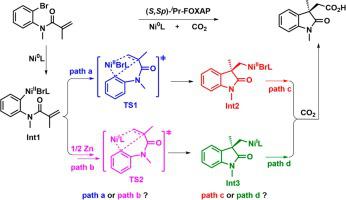Tetrahedron Letters ( IF 1.5 ) Pub Date : 2023-09-07 , DOI: 10.1016/j.tetlet.2023.154741 Hui-Qing Yang , Ya-Ning Hou , Jing-Yun Chen , Sheng-Qiang Guo , Hui-Xian Yang , Xin Wang

|
To provide guiding information for developing efficient catalysts for CO2 carboxylation, we investigated the mechanism of asymmetric reductive carboxylation of N-(2-bromophenyl)-N-methylmethacrylamide with CO2 catalyzed by a nickel complex using density functional theory (DFT) calculations. The reaction was found to proceed via a multistep and elaborate mechanism. Additionally, CO2 exhibits a preference for inserting into the Ni(I) intermediate rather than Ni(II) intermediate. The noncovalent interaction (NCI) analysis reveals that the π-π stacking interactions and hydrogen bonding interactions lead to the stereoselectivity.
中文翻译:

镍配合物催化 N-(2-溴苯基)-N-甲基甲基丙烯酰胺与 CO2 不对称还原羧化反应的理论研究
为了为开发高效的CO 2羧化催化剂提供指导信息,我们利用密度泛函理论(DFT)计算研究了镍配合物催化的N-(2-溴苯基) -N-甲基甲基丙烯酰胺与CO 2的不对称还原羧化反应机理。人们发现该反应是通过多步骤和复杂的机制进行的。此外,CO 2表现出优先插入Ni(I)中间体而不是Ni(II)中间体。非共价相互作用(NCI)分析表明,π-π堆积相互作用和氢键相互作用导致了立体选择性。































 京公网安备 11010802027423号
京公网安备 11010802027423号